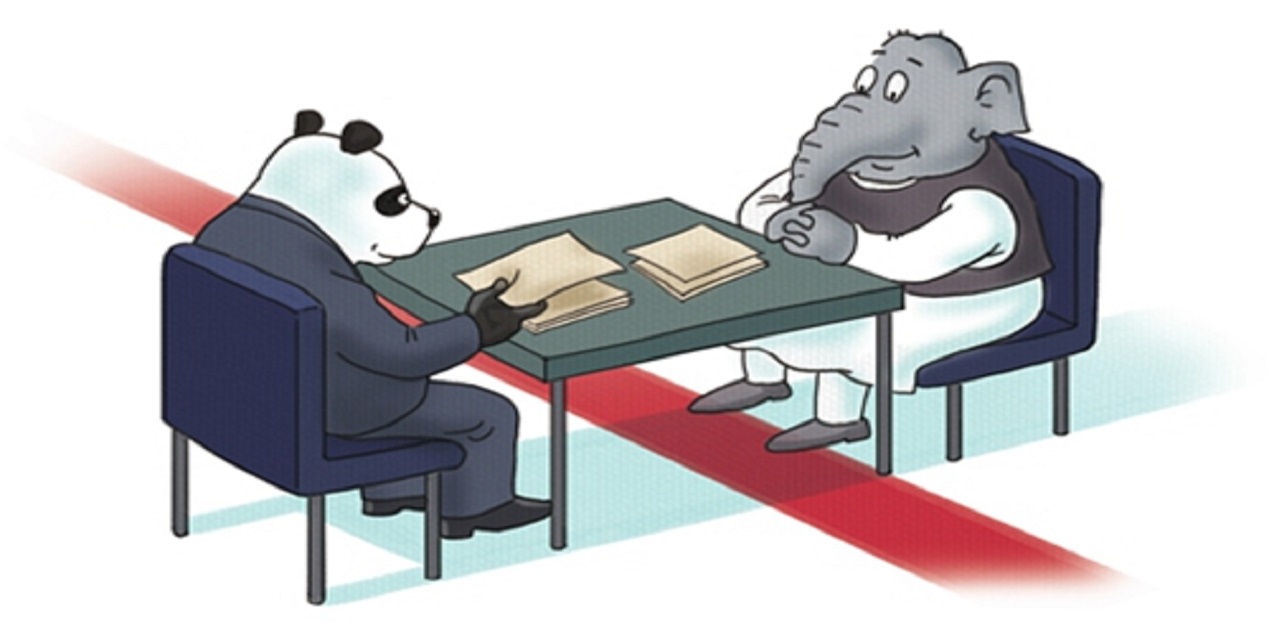A good indication of Chinese thinking on India is discernible from the Chinese print and social media. While China’s English-language publications, like China Daily and Beijing Review, are intended for the English-speaking foreign audience, the Chinese-language media especially caters to the domestic readership. Articles published in Chinese-language publications usually do not appear in the English-language publications and are intended for specific professional audiences and academics. In this context, articles commenting on India –published now as a steady daily criticism -- in the Global Times target the Indian audience. Owned by the Chinese Communist Party (CCP)’s official mouthpiece ‘People’s Daily’, the Global Times also transmits the ‘official line’ and conveys messages that the Chinese authorities want to, but cannot in as blunt and sensational a manner.
Important to note, however, is that China’s media is strictly monitored by the Chinese Communist Party (CCP) Central Committee (CC)’s Propaganda Department. Editors receive ‘guidance’ thrice a day telling them what they can report, prominence it should be given and, in controversial matters, advising them to adhere to the version disseminated by the official news agency Xinhua. Failure to abide by this ‘guidance’ attracts punitive action. Nonetheless, a careful reading of the Chinese media does yield useful information, especially as Chinese President Xi Jinping more liberally censors information and imposes progressively stricter controls thereby increasing opacity.
Three recent articles in the Chinese-language media give an insight into Chinese officialdom’s thinking on Indian geo-economic and foreign policies. Each has appeared in a specialised Chinese academic publication. The third article has been published in Chinese and English by the think-tank to get wider readership.
China's Nanya Yanjiu (South Asian Studies Quarterly - Issue No. 2, 2021), a bimonthly brought out by the University of International Studies at Beijing Foreign Studies, published an article by two academics, Li Tao and Yuan Xiaojiao. The article assessed the theory and practice of the Modi administration’s economic diplomacy. They assess that under the Modi administration, India’s economic diplomacy seeks to attract FDI, build relationships with the global Indian diaspora, and elevate India’s status in regional and multilateral forums. Li Tao and Yuan Xiaojiao argue that India’s economic diplomacy is grounded at a theoretical level in a mixture of neoliberal institutionalism and nationalism. On the one hand, Modi has pursued a pragmatic strategy of cooperation via bilateral and multilateral agreements. Through “selective multilateralism,” India can participate in global multilateral forums while placing some limitations on the impact of globalization and India’s integration into a free and open global economy. At the same time, Modi’s economic diplomacy reflects ‘Hindu nationalism’, urging citizens to limit their material consumption and protect the domestic economy. In this view, India’s economic development is a “duty” of both the Indian individual and the Indian government. According to Li and Yuan, this mixture of ‘neoliberal institutionalism’ and ‘Hindu nationalism’ is evident in India’s economic diplomacy.
The two academics say that at the core are India’s interests. India’s relations with its South Asian neighbours reflect “defensive economic nationalism,” as India uses its influence to protect its national economic interests, and its economic diplomacy is characterized by ‘asymmetric interdependence’. As the largest economy in South Asia, India seeks to increase its neighbours’ economic dependence on India by encouraging the adoption of a common market and offering commercial aid. In its relations with great powers such as China, the United States, Russia, and Japan, India mixes neoliberal institutionalism with economic nationalism; it balances and free rides in an attempt to maintain strategic autonomy and assert regional leadership. For example, India has accepted the US “Indo-Pacific” strategy as a way to fend off pressure from China’s Belt and Road Initiative.
With regard to China, India’s policy has shifted from “soft checks and balancing” to “comprehensive decoupling” in the wake of the 2020–2021 skirmishes in the Galwan valley. At these peripheral and global levels, India adopts liberal economic policies by seeking to expand economic partnerships. Modi has focussed on building relations with Asian countries to attract foreign capital and provide employment opportunities for India’s vast working-age population. Farther afield, Modi has pursued military, energy, and trade deals with Australia and countries in Western Europe and promised credit lines and aid to much of the African continent. Modi has also affirmed India’s commitment to multilateral economic institutions by pursing leadership roles and seeking to reshape global economic governance to reflect a multipolar world order.
Another article published in Guoji Luntan (International Studies - No. 5, 2021) of the China Institute of International Studies, commented on U.S.-India-China relations. Li Qingyan, Associate Research Fellow at the Department for Developing Countries Studies at the China Institute of International Studies, explored US efforts to incorporate India into its Indo-Pacific strategy, which he said is motivated by the US desire to contain China, and Indian motivations for pursuing closer ties with the United States, and the inherent limits to US–Indian relations.
He said under Modi, India has shifted from its traditional “non-alignment” policy to a “multi-alignment” approach that emphasizes building strategic relations with multiple great powers. Politically, the United States, operating under what Li criticises as flawed zero-sum Cold War thinking, views India as a key pillar of its Indo-Pacific strategy. India is happy to acquiesce to the Indo-Pacific strategy because it views cooperation with the United States as a way to achieve its great power ambitions. Consequently, India has increased its dialogues and cooperation with the members of the Quad. In the security field, the United States regards India as a “defense partner” and treats it much as it would treat a formal ally. The two countries share technology and some intelligence, have worked to integrate military operations, and participate in joint military exercises.
Li Qingyan contends that India and the United States have teamed up to oppose the Belt and Road Initiative, painting its projects as “debt traps” and “neocolonialism,” and promoting their own initiatives as an alternative. Despite the strengthening of US–Indian relations, however, Li asserts that geopolitical, security, and economic differences will hinder the development of formal alliance relations. US–Indian relations are limited by conflicting objectives and a lack of mutual trust. India participates in the Indo-Pacific strategy not because it wants to take the United States’ side in the US–China strategic competition, but because India views cooperation with the strategy as the best way to achieve its great power ambitions and establish its regional significance as the world transitions to multipolarity. He points to India's continuing purchase of weapons from Russia and trade frictions that are undermining Indian–US relations. Li Qingyan anticipates continued tension between US policies first developed under Trump’s “America First” approach and those promoted by Modi’s “Made in India” strategy of domestic protectionism. He argues that the “China factor” is not enough to push the United States and India toward alliance relations: India remains unwilling to sacrifice its strategic autonomy for US interests.
Stating that India’s willingness to cooperate with the United States is motivated by India’s perception that China poses a threat to India’s regional dominance and its global influence, Li Qingyan argues, this analysis is completely flawed. He said if India “abandons strategic autonomy” and aligns with anti-Chinese elements in the West, it will lose its opportunity to become a great power. He contends that over the long term, China and India as emerging markets with enormous populations have many common interests and face similar development challenges, which might push the two countries closer together. The two countries have extensive trade relations. They also share the view that the Global South should have a far greater say in global economic governance than it currently does and anticipate that their countries will play increasingly significant roles as the world transitions toward a multipolar order. Furthermore, Li Qingyan expects India’s decision to pursue closer relations with the United States for geopolitical reasons to shift over the longer term. He expects that the United States and China will eventually learn to coexist in a multipolar world, decreasing India’s opportunity to advance its own interests by playing off China and the United States against each other, and strengthening the value of strategic autonomy. Li Qingyan predicts that the Indo-Pacific strategy ultimately will fall away as China and India rise together.
Ouyang Wei, a ‘princeling’ who retired from China’s National Defence University (NDU) as Professor and Senior Colonel and is presently Deputy Director of Academic Committee, Director of Border Studies Center, at the Grandview Institution --ostensibly a private think-tank -- authored a lengthy nearly 6700-word article on the situation along China’s borders. A border affairs expert, Ouyang Wei assessed that China faces increasingly serious challenges at its land and sea borders on almost every side and must urgently reinforce its defences in these regions. In his report titled 'Current Situation in the Building and Development of China's Border and Coastal Defense' posted on the Grandview Institution’s site in mid-October, he noted that the US has stepped up its military presence in the South China Sea and the Taiwan Strait, and uncertainties grow on China’s land borders with India, Afghanistan, Myanmar and North Korea.
Ouyang said the country was facing encroachment, secession and terrorism in some border areas. In his India-specific comments, he stated that "India takes China as a strategic contestant and adopts an approach of “defending the north and advancing eastward”. It has “deployed forces of comparative advantage against China in the disputed land border areas, intensifying its encroachment on China's territory”. At the same time, it has increased its budget for the naval forces and implemented the “Act East Policy” to push into the Pacific Ocean. Joining the “Indo-Pacific Strategy” system, India vigorously interacts with the United States, Japan and Australia. It keeps monitoring and preventing China from expansion into the Indian Ocean. Countries like the Philippines and Vietnam that have unresolved disputes with China over maritime rights and interests are trying to leverage the endorsement of major countries from outside the region so as to counterbalance China’s increasing control over the South China Sea and to grab their own vested interests. Apart from that, the instability and uncertainty in the Korean Peninsula, Myanmar, Afghanistan and other regions has direct impact on China's border and coastal defense”. He assessed that the possibility of intervention by the major powers from outside the region is on the increase.
In a subsequent paragraph he added that China has signed boundary treaties with Myanmar, Nepal, Laos and Vietnam (except India and Bhutan) successively and established the ASEAN Free Trade Area, which has stabilized the security in the southwest border area as a whole. “Keeping a negotiation mechanism and announcing the political guidelines for the settlement of the boundary issue, China has inked the border defence cooperation agreement with India in 2013 in an effort to reduce border friction. However, out of its strategic coveting in the Indo-Pacific region and encouraged by the US Indo-Pacific Strategy, India has readjusted its strategy towards China in recent years, taking a hardline anti-China stance on the Belt and Road Initiative and territorial disputes”. He added “It has built up military deployment in border areas and encroached on China's territory. The 2017 Doklam Standoff in the Sikkim sector of the China-India border, the 2019 Ladakh clash, and the 2020 border conflict in the Galwan river valley that resulted in casualties, show that the task of defending and managing the Sino-Indian land border is far more demanding than in other directions. As strategically both China and India have clear intention to avoid military conflict, and besides, the reorganization of China’s military forces acts as a counterweight to India's deployment of border forces, the Sino-Indian border disputes are held under control for the time being. It is very unlikely that local clash and war harming the overall stability of the border areas and bilateral relations should occur". He also discussed the situation with Myanmar and maritime territorial issues in detail.
Around almost the same time the English-language version of the Global Times published a toughly-worded article.
The Global Times (October 11) article, second in as many days, referred to the PLA Western Theatre Command statement released the same day, which claimed "China has made tremendous efforts to ease and calm the border situation, while India insisted on unreasonable and unrealistic demands, adding difficulties to the negotiations". It quoted the PLA Western Theatre Command statement that "China's determination to safeguard sovereignty is unwavering, and China hopes India will not misjudge the situation". It said "the "status quo" that India referred to is to legitimise their continuous encroachment on Chinese territory. India's statement said the "resolution of the remaining areas would facilitate progress in the bilateral relations. This shows the Indian side's current attitude of linking border disputes with overall China-India relations and trying to coerce the Chinese side to make concessions". It said the border issue between China and India remains stuck because the "Indian side still hasn't developed a correct attitude in the negotiations. It always makes unrealistic demands not in line with the real situation or its strength". It added that "New Delhi anticipates Beijing softening its stance over the border issue and yielding to its demands to prevent New Delhi from aligning itself with Washington against Beijing" and that "such an opportunistic attitude has lowered India's status in international politics as a major power, because this tactic will not work between great powers. The border issue is related to the dignity of all nations. So when border conflicts occur between two major countries, it needs to be managed based on major power relations. And for any of these countries trying to coerce the other side to make concessions not in line with the real situation and are detrimental to its national interests creates a problem for itself. This is because its goal is impossible to achieve, and will only create trouble for itself".
The Global Times warned "The Chinese people know that both China and India are great powers with enough national strength to sustain a long-time border standoff with each other. Such mutual attrition is regrettable, but if India is willing to do so, China will keep it company until the end. New Delhi needs to be clear about one thing: it will not get the border the way it wants. If it starts a war, it will definitely lose. Any political maneuvering and pressure will be ignored by China". It said "India is indulging itself this way. It has lackluster abilities, but has turned itself into a "superpower of patriotism." In addition to border disputes with China, India also often raises unreasonable demands over other issues". In conclusion the article said "In handling the border dispute with India, it is of the utmost importance for China to do two things. First, we should stick to the principle that no matter how India makes trouble, China's territory belongs to China and we will never cede it. The second is to be patient and be prepared for a military struggle in the event of a deteriorating scenario, but do our best to maintain peace in the China-India border area. India is still sleepwalking on the border issue. We can wait for it to wake up".
The contrast in styles and aggression between the Global Times’ reporting and other articles is evident, but the content is similar! All emphasise that China is in a stronger position, but chooses not to take tougher measures. There is also the suggestion that the US and China will, over time, possibly reach some sort of modus vivendi.
(The paper is the author’s individual scholastic articulation. The author certifies that the article/paper is original in content, unpublished and it has not been submitted for publication/web upload elsewhere, and that the facts and figures quoted are duly referenced, as needed, and are believed to be correct). (The paper does not necessarily represent the organisational stance... More >>
Image Source: https://www.globaltimes.cn/Portals/0/attachment/2020/2020-06-24/ae518587-b2df-45e7-97d8-8775d8c6ef30.jpeg











Post new comment